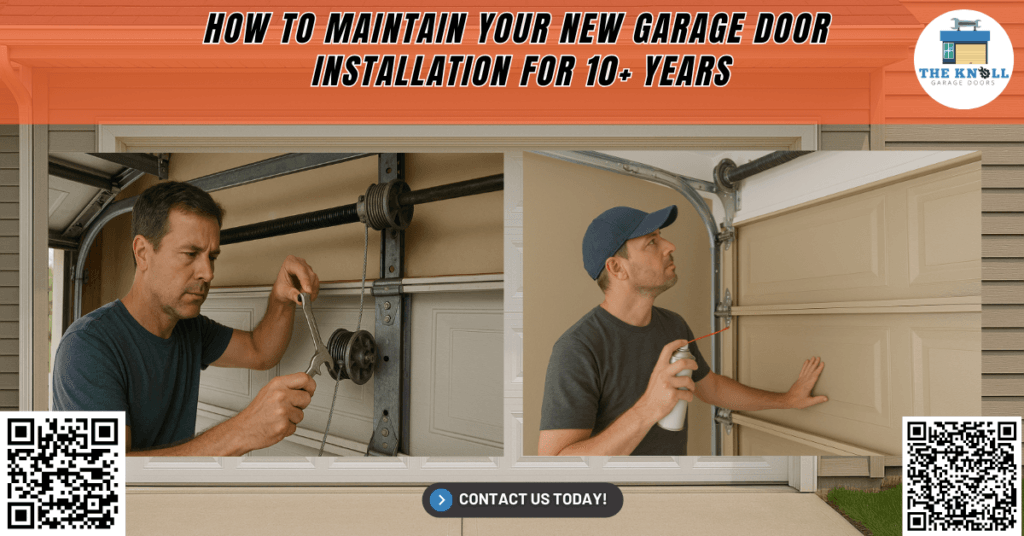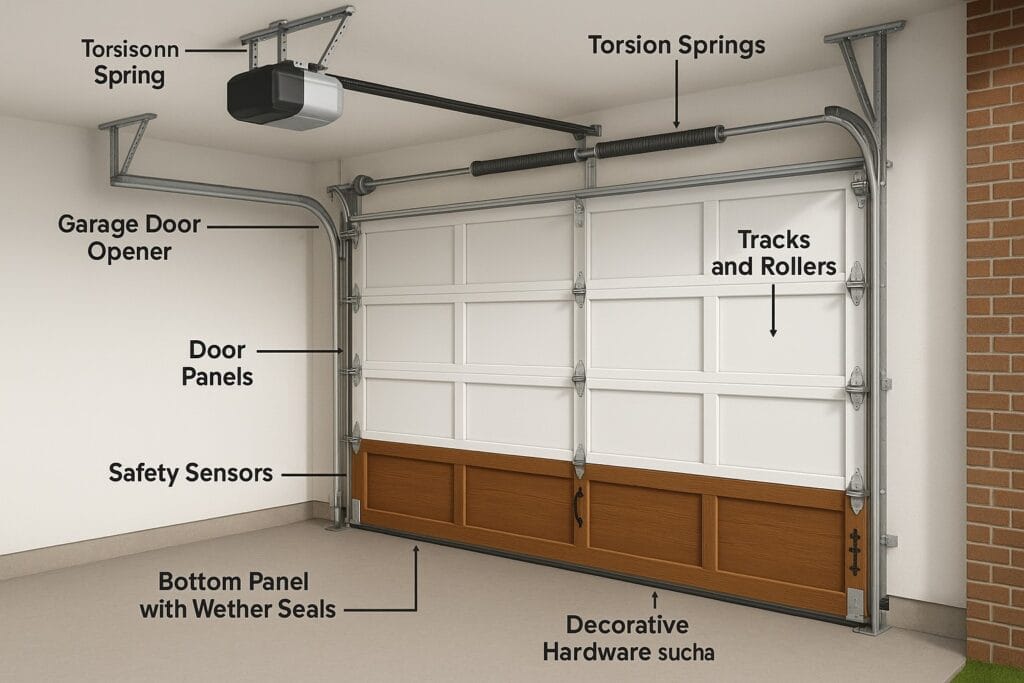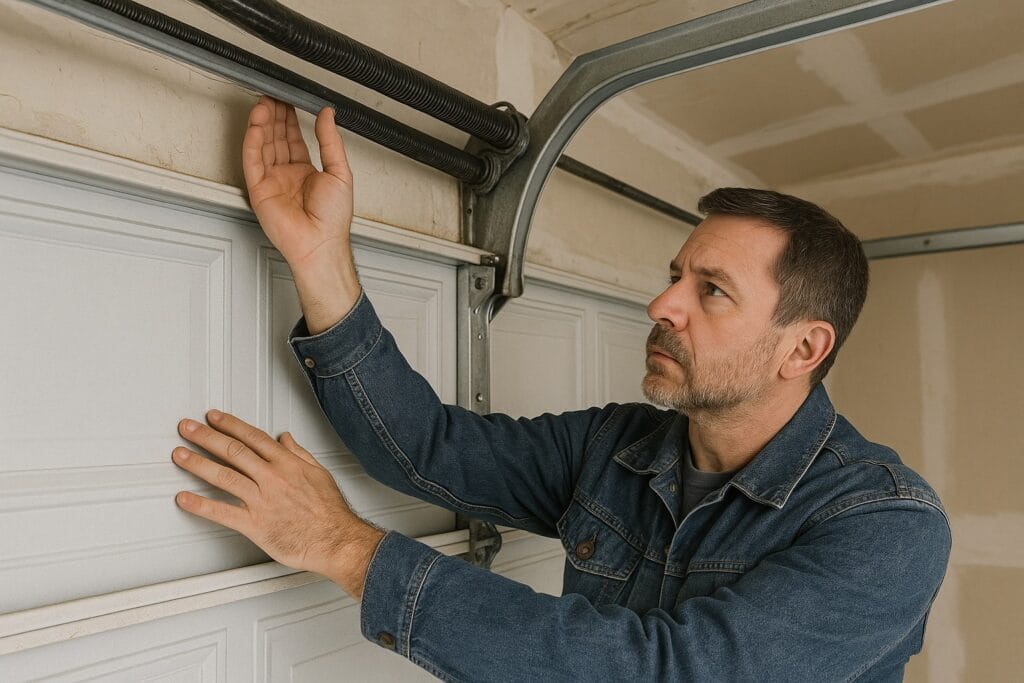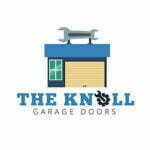How to Maintain Your New Garage Door Installation for 10+ Years

Your garage door is more than a simple entry point. It plays a pivotal role in your home’s security, curb appeal, energy efficiency, and day-to-day convenience. At The Knoll Garage Doors, we’ve witnessed what happens when new garage door installations aren’t properly maintained. One memorable case involved a homeowner in College Station who invested in a beautiful, insulated steel door with a smart garage door opener. Unfortunately, after just three years of irregular maintenance, the springs snapped, the opener failed, and the decorative hardware had rusted due to local humidity. It cost thousands to replace, all of which could have been prevented with a consistent upkeep routine.
According to the International Door Association, the average garage door opens and closes more than 1,500 times a year. That’s a lot of stress on your springs, panels, hardware, and opener system. If you take the time to maintain your garage door, it can last 10 years or longer with smooth operation and minimal labor costs. Think of it as you would your car: change the oil, rotate the tires, and it will serve you for years. A garage door system, from its steel tracks to its bottom panel and safety sensors, requires the same level of attention.
At The Knoll Garage Doors, we proudly serve College Station, TX, and nearby areas with expert garage door installation, repair, and maintenance services. Whether you’re managing a residential property or overseeing a commercial project, we provide tailored care for everything from Stanley garage doors to advanced powerlift openers. This step-by-step guide will walk you through maintaining your new garage door installation so it performs like new for over a decade.
Why Garage Door Maintenance Matters
A new garage door installation is a significant investment in your home. It’s not just about the cost of the door itself, but the materials, insulation value (R-value), opener system, installation team labor, and ongoing upkeep that determine your overall cost and value. Ignoring routine maintenance can lead to:
- Broken springs or cables
- Rusted hardware and corroded fasteners
- Misaligned or jammed rollers and tracks
- Noisy and erratic operation
- Faulty garage door openers
- Reduced energy efficiency and higher energy bills
- Off-track door panels and unsafe conditions
- Diminished curb appeal and lower property value
Regular maintenance ensures safe operation, enhances energy efficiency, and helps maintain the manufacturer’s warranty. By prioritizing care, homeowners can avoid early replacement costs, protect their home from weather damage, and enjoy uninterrupted access and remote access features without worry.
Garage doors are heavy, complex systems that operate under high tension. Without regular care, wear and tear will eventually cause parts to degrade, creating hazardous conditions and increased repair costs. Routine inspections and minor adjustments can extend the lifespan of every component, saving time, money, and stress in the long run.
Understanding the Anatomy of Your Garage Door System
Knowing the key components of your garage door helps you better understand what needs regular attention. Here are the parts involved in a standard new garage door installation:

- Door Panels: Sections of the door (often 3-5 panels) that fold and move along tracks. These panels may be made of steel, aluminum, wood, or composite materials, and may include insulation layers or decorative elements.
- Springs: Torsion or extension springs counterbalance the door’s weight and make it possible to lift manually or with a motor. These are critical for smooth operation and require professional adjustment when worn.
- Tracks: Steel tracks guide the rollers and panels during movement, mounted vertically and horizontally along the garage ceiling and frame.
- Rollers: Nylon or steel wheels that glide within the track, allowing smooth motion. Worn rollers lead to noisy, jerky movements.
- Hinges: Connect door panels and allow flexibility when opening/closing. Hinges can wear out over time and may require tightening or replacement.
- Garage Door Opener: The motorized drive carriage that automates door movement (options include chain, belt, screw, or jackshaft types). This component can include smart features like Wi-Fi access, battery backup, and security locks.
- Safety Sensors: Positioned near the bottom of the door frame, these reverse the door if an object is detected in its path. Malfunctioning sensors can lead to safety risks.
- Bottom Panel and Weather Seal: The bottom of the door includes a rubber or vinyl seal that prevents water, dirt, pests, and air drafts from entering the garage. It also cushions the impact when closing.
Familiarizing yourself with these components gives you the insight to notice when something isn’t working quite right. Understanding their roles also helps you communicate effectively with technicians when service is needed.
Monthly Garage Door Maintenance Tasks
Even if you’re not a technician, there are several monthly tasks every homeowner can perform to extend the life of their garage door.
- Conduct a Visual Inspection
- Look for wear and tear on all components:
- Springs should be tightly wound and rust-free
- Cables must not be frayed or slack
- Hinges and hardware shouldn’t wobble or show signs of corrosion
- Rollers should spin freely without cracking or sticking
- Door panels must be dent-free, properly aligned, and free from rust or rot
- Safety sensors should be clean, clear of debris, and aligned with each other
Use a flashlight and pay close attention to the bottom panel, which is most susceptible to moisture damage and pest entry. If you notice anything unusual, take note and plan for prompt repairs.
- Test Door Balance and Weight
Disconnect the opener using the emergency release cord. Manually lift the door to the halfway point. It should stay in place without drifting. If it slips or feels heavy, the springs may be unbalanced, a safety issue that requires professional adjustment. Unbalanced doors put strain on the opener and can cause premature wear or failure.
- Verify the Auto-Reverse Safety System
Place a wooden block or object in the door’s path. Press the close button. The door should automatically reverse upon contact. If it doesn’t, your safety sensors or opener settings need adjustment. This test ensures the safety of children, pets, and belongings that might cross the door’s path.
Seasonal Maintenance Tips for College Station Homes
Every 3 to 4 months, take these extra steps to ensure your garage door system is working at peak performance:
- Lubricate All Moving Parts
- Use a silicone-based or lithium grease lubricant on:
- Springs
- Hinges
- Rollers
- Bearings
- Opener chains or screw drive carriages
Avoid oil-based lubricants like WD-40 that can attract dust and break down protective coatings. Proper lubrication reduces noise, prevents rust, and promotes smoother movement of all hardware components.
- Clean Tracks and Door Frame
Use a damp cloth to clean both sides of the steel track. Remove any leaves, dirt, or debris that may be caught in the rollers or bottom panel area. Keep the door frame clear of cobwebs, and make sure the tracks are properly aligned. Misalignment can cause rollers to derail and compromise the opener.
- Inspect and Replace Weatherstripping
Texas humidity and fluctuating temperatures can wear down seals. Check the rubber seal on the bottom panel and replace it if it’s cracking, flattening, or letting in air. This improves energy efficiency and keeps insects out. Consider upgrading to vinyl bulb seals or threshold seals for enhanced protection.
Annual Garage Door Maintenance Guide
Once a year, dedicate time to these deeper inspections and tune-ups to extend your new garage door’s lifespan.
- Tighten All Nuts, Bolts, and Hardware
- Using a socket wrench, tighten all visible screws and bolts on:
- Hinges
- Roller brackets
- Track mounting plates
- Garage door opener brackets
Loose hardware contributes to noise, misalignment, and potential damage during operation. Tightening these parts restores structural integrity and quiet operation.
- Check Opener Settings and Battery
Test the opener’s force settings, remote access range, and wall switch. Replace batteries in remotes and keypads. If your opener lacks modern features like Wi-Fi integration or battery backup, consider an upgrade to a smart, energy-efficient opener.
Smart openers provide real-time alerts, remote control access, auto-locking features, and integration with security systems. These upgrades also improve convenience and home security.
- Clean and Touch-Up Panels
Wash garage door panels with a gentle solution of soap and water. Inspect for scratches, rust, or paint chips. For wooden doors, apply a new coat of paint or sealant to prevent moisture intrusion and rot. Keeping the exterior clean and well-coated enhances appearance and protects materials from weathering.
- Professional Tune-Up
Call The Knoll Garage Doors for a complete inspection. We will:
- Test spring tension
- Adjust track alignment
- Inspect drive carriage and opener motor
- Calibrate safety sensors
- Check door balance
- Ensure proper alignment of the door frame and opener assembly
Annual servicing prevents hidden problems from escalating into expensive repairs. It also ensures that your system complies with safety standards and performs efficiently.
Texas Weather Tips: Protect Your Garage Year-Round
In College Station, your garage door must handle extreme summer heat, heavy rains, and seasonal storms. Here’s how to weatherproof your investment:
- Install an Insulated Garage Door: Choose a new door with polyurethane or polystyrene insulation for improved R-value and energy conservation.
- Seal Gaps and Cracks: Regularly inspect the door frame and corners for air leaks. Apply caulking or foam insulation where needed.
- Use a Surge Protector: Shield your garage door opener from lightning-induced power surges, especially during thunderstorm season.
- Storm Reinforcements: Ask about wind-load-rated steel doors that comply with Texas building codes for storm protection. Consider horizontal bracing systems or reinforced panels.
- Protect Paint and Coatings: Use UV-resistant paints or finishes to prevent fading and cracking from sunlight exposure.
Preventing Common Garage Door Problems
Even with regular maintenance, certain issues may arise over time due to the natural wear of components. Here’s how to identify and prevent the most common garage door problems to ensure long-term performance and safe operation:

Broken Springs
Garage door springs are essential for lifting and lowering the door smoothly. Over time, they weaken due to tension cycles. On average, torsion springs last for around 10,000 cycles (one cycle equals one opening and closing). When a spring breaks, it can render the door inoperable and dangerous to handle.
Signs of Trouble:
- Loud banging or snapping noise
- Door slams shut or refuses to open
- Noticeable gaps in the spring
Prevention Tips:
- Schedule annual spring inspections
- Avoid manually forcing the door if the spring is compromised
- Replace both springs simultaneously if one fails to maintain balance
Noisy Operation
Grinding, squealing, or rattling noises may indicate friction, lack of lubrication, or worn hardware.
Possible Causes:
- Dry or corroded rollers
- Loose bolts and brackets
- Metal-on-metal contact from misaligned tracks
Prevention Tips:
- Apply garage-specific lubricant every season
- Upgrade to nylon rollers for quieter performance
- Retighten all hardware annually
Door Off Track
A garage door that jumps off its track is not only inconvenient but also hazardous. It can result from impact, debris, or a misaligned track.
Indicators:
- Uneven door movement
- Gaps between rollers and tracks
- Jerking or dragging during operation
Prevention Tips:
- Keep the area around the tracks clear
- Don’t bump the door with vehicles or objects
- Have a professional realign the track if needed
Opener Malfunctions
The garage door opener is the command center of the entire system. If it stops functioning correctly, it may be due to mechanical or electrical failure.
Common Issues:
- Dead remote batteries
- Signal interference
- Damaged drive carriage or gear
Prevention Tips:
- Replace opener batteries annually
- Install surge protection
- Schedule a tune-up for recalibration and cleaning
Expert Tips from Our Installation Team
The Knoll Garage Doors installation team has years of hands-on experience with all types of garage doors and openers. Our seasoned experts recommend these pro strategies for maximizing your door’s lifespan:
- Choose the Right Garage Door: Select high-quality, insulated steel or composite doors that offer energy savings and durability for Texas weather.
- Be Gentle With the Opener: Use the wall switch instead of the remote when possible to prevent overuse of the drive system.
- Avoid DIY Repairs: Especially with springs, cables, and electrical components. One wrong move can be dangerous and lead to costly damage.
- Upgrade for Convenience: Smart openers with mobile app control and real-time alerts allow you to monitor usage and get alerts if something goes wrong.
- Check Alignment Regularly: An unaligned opener or track can cause severe damage over time. Look for uneven gaps or jerky movement.
Maintaining Visual Appeal and Value
Your garage door is often one of the first things people notice about your home. Keeping it clean and visually appealing enhances your curb appeal and property value. Here’s how to maintain your garage’s aesthetic and structural integrity:
- Wash Monthly: Use a soft cloth, mild detergent, and water to remove dirt, pollen, and buildup.
- Polish Windows and Inserts: If your garage door features decorative windows or inserts, clean them with non-abrasive glass cleaner.
- Touch Up Paint or Finish: Repair scratches, chips, and fading to prevent corrosion and retain the door’s original color.
- Inspect Trim and Frame: Check for rot, rust, or damage to the garage frame and replace trim when needed.
- Maintain Lighting and Entry Keypads: Keep exterior garage lights functional and clean. Replace bulbs and test keypads regularly for responsiveness.
These simple visual enhancements not only improve your home’s aesthetics but also protect your investment against weather-related deterioration.
How Can The Knoll Garage Doors Help You?
Your garage door deserves the same care as your roof, HVAC, or plumbing systems. And with the help of The Knoll Garage Doors, keeping it in excellent condition is simple and stress-free. Based in College Station, TX, we proudly serve homeowners and businesses throughout the Brazos Valley with top-quality garage door services.
We specialize in:
- New garage door installation: Custom-built doors, energy-efficient models, and full-service setup
- Custom door design and door replacement: Get a door that fits your style, home architecture, and usage needs
- Annual maintenance and safety inspections: We handle spring adjustments, opener calibration, and safety checks
- Emergency garage door repairs: Fast service when you need us most, including broken springs and jammed openers
- Smart opener upgrades and remote access integration: Stay connected and in control of your garage at all times
Whether your project involves a Stanley garage door, roll-up door, or energy-efficient insulated panel system, our trained team ensures a professional, reliable experience every step of the way.
📧 Address: 2322 Texas Ave S, College Station, TX 77840
📞 Phone: (979) 978-0221
🔗 Schedule Service: Call now or visit our website to book your appointment
Let us help you conserve energy, improve security, and ensure your garage door operates smoothly for years to come. Trust The Knoll Garage Doors, where quality meets commitment.
Frequently Asked Questions (FAQs)
1. How often should I replace the weatherstripping on my garage door?
Weatherstripping should be inspected every 6 months and typically replaced every 1 to 2 years, depending on climate exposure and wear.
2. Can I paint my insulated garage door without damaging the insulation?
Yes, you can paint insulated garage doors, but use exterior-grade, non-reflective paint and avoid drilling or puncturing the panels to preserve insulation.
3. What garage door opener type is best for quiet operation in attached garages?
Belt drive openers are ideal for quiet operation and are recommended for garages attached to living spaces.
4. How can I reduce energy consumption through my garage door in the summer?
Opt for a high R-value insulated garage door, seal all gaps, and use light-colored panels to reflect heat away from your garage.
